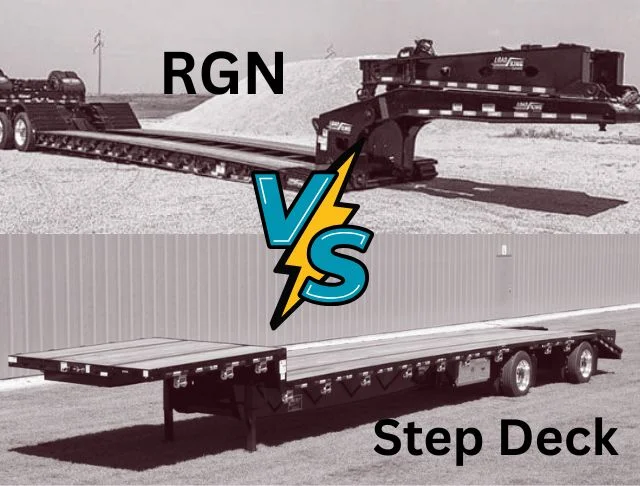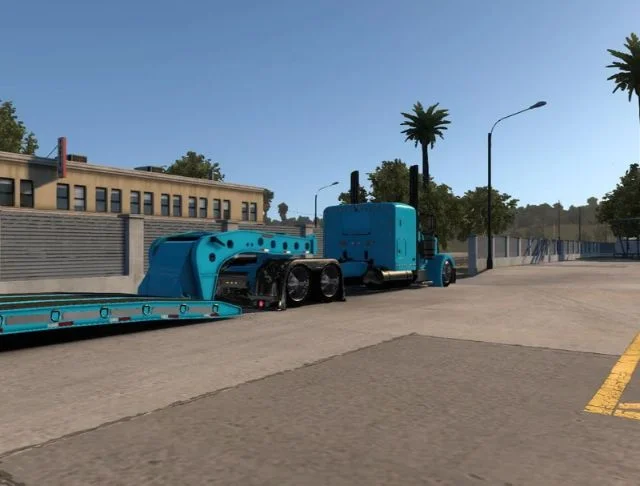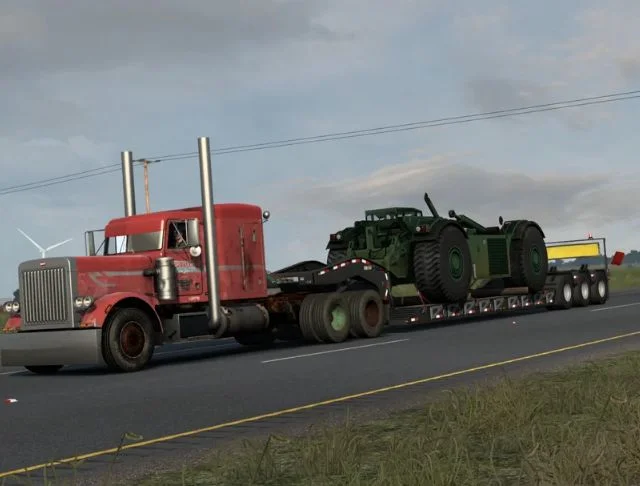by Abdullah Faraz
April 8, 2025
Reviewed by Ford
Truck Dispatch Specialist
RGN and a lowboy are trailers that are attached to semi trucks. Step deck refers to a type of trailer, but the term is sometimes used to refer to the truck as well.
But I made it simple and easy to understand that you’ll hardly find elsewhere.
I’ll explain here the difference between RGN, step deck, lowboy trailer, and all important terminologies related to them, like neck and gooseneck.
Important Terminologies

Before understanding the difference between RGN and step deck, let’s understand the important terminologies which will help make the learning process easier.
Trailer
A trailer is a non-powered vehicle that is towed by a truck to transport goods or heavy equipment. It comes in various types, such as flatbed, lowboy, and refrigerated, depending on cargo requirements.
Truck
A truck is a motor vehicle designed to transport cargo. In freight logistics, it typically refers to the powered part of a tractor-trailer unit, capable of hauling various trailer types.
Cab
The cab is the front section of a truck where the driver sits. It contains the controls, steering wheel, and seats, and may include a sleeping compartment in long-haul trucks (called a sleeper cab).
Power Only
Power only refers to a trucking service where only the truck and driver are provided, while the trailer is supplied by the shipper or broker. It’s commonly used for moving preloaded trailers.
Skeleton Trailer (or Skeletal Trailer)
A skeleton trailer is a lightweight, bare-frame trailer used primarily for transporting shipping containers. It’s designed with minimal structure to reduce weight and improve fuel efficiency.
Axle
An axle is a central shaft for rotating wheels. In trucking, it plays a key role in supporting the trailer’s weight and maintaining balance. More axles allow for heavier loads.
Neck
The neck is the front part of a trailer that connects to the truck’s fifth wheel. It plays a key role in attaching and distributing weight from the trailer to the truck.
Gooseneck
A gooseneck is a curved or angled type of trailer neck that connects over the truck’s rear axle. In some trailers, it’s removable, allowing equipment to be driven onto the trailer from the front.
Deck
The deck is the flat surface area of a trailer where cargo is placed. It serves as the main loading platform and can vary in height and design depending on the trailer type.
Step Deck
A step deck, also known as a drop deck trailer, is a type of flatbed trailer with two deck levels. It allows for taller cargo than standard flatbeds by lowering the rear deck.
Lowboy
A lowboy is a trailer with an extremely low deck height, used to transport tall or heavy equipment that would exceed height limits on other trailers.
RGN (Removable Gooseneck)
An RGN is a type of lowboy trailer with a removable front section, allowing machinery to be driven directly onto the trailer. It’s ideal for hauling construction equipment or oversized loads.
Note: These definitions are taken from generative AI for elaboration purposes with accuracy checks.
RGN Vs. Step Deck – Key Differences

The main difference between RGN trailer and step deck trailer is that RGN or lowboy trailer comes with extremely low deck height, can be detached from the front, and is mainly used for carrying heavy and oversized loads like construction equipment or even vehicles.
The other main difference is that the RGN trailer is detachable, so vehicles like bulldozers can be driven over it and loaded, while step deck trailers are loaded from the back or sides. RGN has two upper decks while the step deck trailer has one upper deck.
RGN Vs. Step Deck – Profitability

If you want to start a trucking business, then you must think about which trailer type pays more.
If you attach an RGN or low-boy trailer to your semi truck, this is more profitable, but the science behind its profitability is:
- You need experience to handle specific heavy and oversized loads, so training is hard and starting is slightly more difficult than flatbed.
- You’ll face stricter legal restrictions and extra permits.
- Driving is harder and more time-consuming as due to heavy weight, you cannot go beyond a certain speed limit.
- Load options are not widely available, and you may be stuck in some locations.
- Due to these extra efforts, you’ll get extra bonuses and high-paying loads that directly increase your weekly gross.
Profitability Comparison Table

| Factor | RGN Trailer | Step Deck Trailer |
| Rate Per Load | Higher | Moderate |
| Operating Costs | Higher | Lower |
| Load Availability | Limited (niche-specific) | High (general freight) |
| Permit Requirements | Often needed | Usually not needed |
| Maintenance Cost | High | Moderate to low |
| Driver Experience | Experienced required | Standard CDL |
| Business Model Fit | High-ticket, low-frequency loads | Medium-ticket, high-frequency loads |
| Upfront Investment | Expensive | More affordable |
Expert Advice
Don’t overthink selecting a specific type of truck like flatbed, step deck, reefer, or lowboy. If you handle or let handle the truck dispatching seamlessly, you can earn higher and consistently with any truck type.
RGN Vs. Step Deck – Rental Needs

Choosing between an RGN (Removable Gooseneck) and a Step Deck trailer depends on the type of cargo you need to move. Both are great for hauling oversized loads, but they serve different purposes:
RGN
Best For:
- Construction or industrial equipment
- Self-loading machinery
- Loads exceeding 10 ft in height
Rental Considerations:
- More expensive to rent due to specialized design
- Heavier and longer may require special permits.
- Ideal for occasional oversized load needs
Step Deck
Best For:
- Tall loads that don’t need to be driven onto the trailer
- Palletized freight, lumber, or machinery that can be forklift-loaded
- Legal-height loads under 10 ft
Rental Considerations:
- Cheaper and more widely available
- Easier to maneuver than RGNs
- Perfect for daily or general freight hauling
RGN vs. Step Deck – Rental Needs Comparison
| Feature | RGN Trailer | Step Deck Trailer |
| Neck Type | Removable Gooseneck | Fixed Neck |
| Loading Method | Drive-on from the front | Forklift or crane from side/rear |
| Deck Levels | Single low deck | Two levels (upper & lower) |
| Max Load Height | Up to 12 feet | Up to 10 feet |
| Best For | Heavy machinery & self-powered equipment | Tall palletized or non-powered cargo |
| Rental Cost | Higher | Lower |
| Permit Requirements | Often needed | Usually not needed |
| Availability | Less common, more specialized | More common & widely available |
Conclusion
RGN and step deck are both trailers designed to carry heavy loads, but RGN is closer to the ground, so it can carry oversized objects that step deck cannot allow. RGN is higher-paying to owner operators than step deck for extra efforts, care and safety. If you want to ship 10 to 12 feet, then rent RGN or lowboy; otherwise, if the load size is below 10 feet, then a step deck is good.